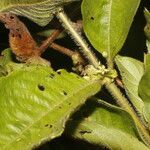Woody vines, the branchlets terete, villose, the hairs spreading. Leaves ellip-tic to elliptic rhomboid, rarely oblong rotund or obovate, 4-14 cm long, 1.8-6.0 cm wide, deltoid, widely deltoid to subobtuse at the apex, cuneate to obtuse at the base, the costa prominulous above and beneath, the lateral veins 8-12, ar-cuate, stiffly chartaceous, concolorous or discolorous, the hairs elongate above, often restricted to the costa and the veins, densely hairy beneath, the hairs spreading; petioles slender, to 1.5 cm long; stipules ovate oblong, to 1.3 cm long, the hairs spreading outside, glabrous within. Inflorescences axillary, usually found in all the axils of the ultimate twiglets, epedunculate, the flowers congested, the heads to 1.2 cm in diam. Flowers sessile; hypanthiumr densely pilose or hir-sute, the calycine cup ca. 1 mm long, the lobes 5, narrowly ovate oblong, to 4 mm long, glabrous or with a few elongate hairs within, pilose or hirsute outside; corolla white, the tube narrowly infundibuliform, to 5 mm long, ca. 0.6 mm wide, densely or sparsely pilose outside, the lobes 5, triangular, 1.0-1.8 cm long, acute. Fruits sessile, rotund or oblong, to 0.8 cm long, pink, purple, lavender, densely to sparsely golden pilose, the calycine lobes persistent, often reflexed.
More
A slightly woody vine. It grows 5 m long. The stems are green and 5 mm across. The leaves are opposite and 6-12 cm long by 3-6 cm wide. They are narrowly oval. The flowers are in clusters in the axils of leaves and do not have stalks. The flowers are white, tube shaped and 6-7 mm long. The fruit is a round berry. The fruit are dark red to purple and 7-10 mm long. .




